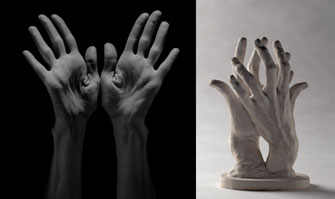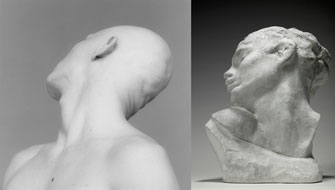A Century Apart in Time,
Brothers in Sensibility

Left: “Lucinda Childs” (1985), by Robert Mapplethorpe. © 2014 Robert Mapplethorpe Foundation, Inc. All rights reserved. Right: “Assemblage: Deux Mains Gauches,” by Auguste Rodin. © Paris, Musée Rodin. Photo: C. Baraja
The photographer Robert Mapplethorpe dreamed of exhibiting in Paris. This spring, 25 years after his death at the age of 43 from complications of AIDS, two shows are belatedly realizing his dream: “Robert Mapplethorpe” at the Grand Palais and “Mapplethorpe-Rodin” in the more intimate setting of the Musée Rodin.
The Grand Palais offers a retrospective of 250 photographs spanning his whole short career, while the Rodin Museum sets out to create a dialogue between the Parisian sculptor and the New York photographer by juxtaposing 60 Rodin sculptures with 100 Mapplethorpe photographs.
They worked a century apart in different worlds and using different mediums, yet the show succeeds in capturing a shared essence in their art – a similar approach to the use of light and shade, and a similar obsession with sensuality.
The exhibition is divided into sections, each comparing like with like: the use of black and white; the use of light and shade; a taste for detail; assemblages and compositions; eroticism and damnation; drapery, material and abstraction; movement and tension.
Mapplethorpe liked pure lines and clean forms. As an art student, his first great love was Michelangelo. He often said that he could have been a sculptor, and this show proves the

Left: “Robert Sherman” (1983), by Robert Mapplethorpe. © 2014 Robert Mapplethorpe Foundation, Inc. All rights reserved. Right: “Tête de la Luxure” (1907). © Paris, Musée Rodin. Photo: C. Baraja
point. At a technical level, the way he used contact sheets to crystallize and develop his ideas parallels the way Rodin worked out his forms in plaster studies.
The photographer’s sculptural sense of space and movement is strikingly demonstrated in a comparison of two works: Mapplethorpe’s 1987 figure study of Michael Reed and Rodin’s 1907 bronze, “L’Homme qui Marche,” each representing a well-muscled male nude, headless and armless, in purposeful mid-stride.
There are differences, of course. Nothing in Mapplethorpe’s art is left to chance; every image is meticulously conceived and posed. One of his favorite models, Ken Moody, described the atmosphere of his studio as being almost like a technical laboratory. Rodin, on the other hand, for all his meticulous preparation, allowed the accident of the material to play its part in the final outcome.
Obviously, there are other differences as well. Rodin loved women, while Mapplethorpe was gay, yet when either one worked with a nude body of either sex, the results were equally electric. Perhaps each was channeling the energy of his place and time – the Moulin Rouge and the maisons closes of Paris in the naughty 1890s for one, the clubs and gay dives of 1970s New York for the other. Parallels in art imitating parallels in life? Vice versa? Go figure.
Musée Rodin: 79, rue de Varenne, 75007 Paris. Métro: Varenne or Invalides. Tel.: 01 44 18 61 10. Open Tuesday-Sunday, 10am-5:45am, Until 8:45pm on Wednesday. Closed Monday. Admission: €9. Through September 21. www.musee-rodin.fr
Reader reaction: Click here to respond to this article (your response may be published on this page and is subject to editing).
Please support Paris Update by ordering books from Paris Update’s Amazon store at no extra cost. Click on your preferred Amazon location: U.K., France, U.S.
More reviews of Paris art shows.
© 2014 Paris Update
Favorite